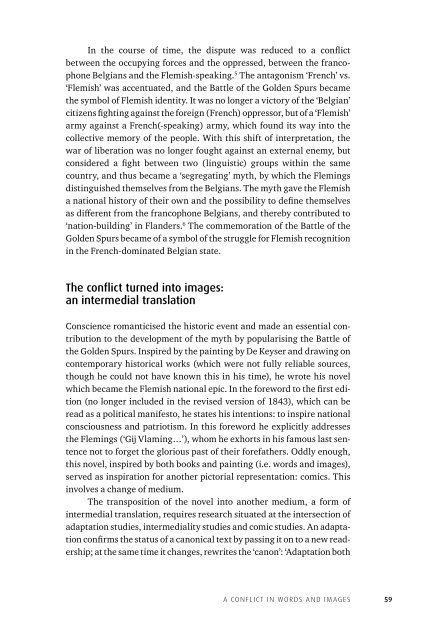Discord Consensus
7aze300jFJo
7aze300jFJo
Create successful ePaper yourself
Turn your PDF publications into a flip-book with our unique Google optimized e-Paper software.
In the course of time, the dispute was reduced to a conflict<br />
between the occupying forces and the oppressed, between the francophone<br />
Belgians and the Flemish-speaking. 5 The antagonism ‘French’ vs.<br />
‘Flemish’ was accentuated, and the Battle of the Golden Spurs became<br />
the symbol of Flemish identity. It was no longer a victory of the ‘Belgian’<br />
citizens fighting against the foreign (French) oppressor, but of a ‘Flemish’<br />
army against a French(-speaking) army, which found its way into the<br />
collective memory of the people. With this shift of interpretation, the<br />
war of liberation was no longer fought against an external enemy, but<br />
considered a fight between two (linguistic) groups within the same<br />
country, and thus became a ‘segregating’ myth, by which the Flemings<br />
distinguished themselves from the Belgians. The myth gave the Flemish<br />
a national history of their own and the possibility to define themselves<br />
as different from the francophone Belgians, and thereby contributed to<br />
‘nation-building’ in Flanders. 6 The commemoration of the Battle of the<br />
Golden Spurs became of a symbol of the struggle for Flemish recognition<br />
in the French-dominated Belgian state.<br />
The conflict turned into images:<br />
an intermedial translation<br />
Conscience romanticised the historic event and made an essential contribution<br />
to the development of the myth by popularising the Battle of<br />
the Golden Spurs. Inspired by the painting by De Keyser and drawing on<br />
contemporary historical works (which were not fully reliable sources,<br />
though he could not have known this in his time), he wrote his novel<br />
which became the Flemish national epic. In the foreword to the first edition<br />
(no longer included in the revised version of 1843), which can be<br />
read as a political manifesto, he states his intentions: to inspire national<br />
consciousness and patriotism. In this foreword he explicitly addresses<br />
the Flemings (‘Gij Vlaming . . . ’), whom he exhorts in his famous last sentence<br />
not to forget the glorious past of their forefathers. Oddly enough,<br />
this novel, inspired by both books and painting (i.e. words and images),<br />
served as inspiration for another pictorial representation: comics. This<br />
involves a change of medium.<br />
The transposition of the novel into another medium, a form of<br />
intermedial translation, requires research situated at the intersection of<br />
adaptation studies, intermediality studies and comic studies. An adaptation<br />
confirms the status of a canonical text by passing it on to a new readership;<br />
at the same time it changes, rewrites the ‘canon’: ‘Adaptation both<br />
A conflict in words and images 59


